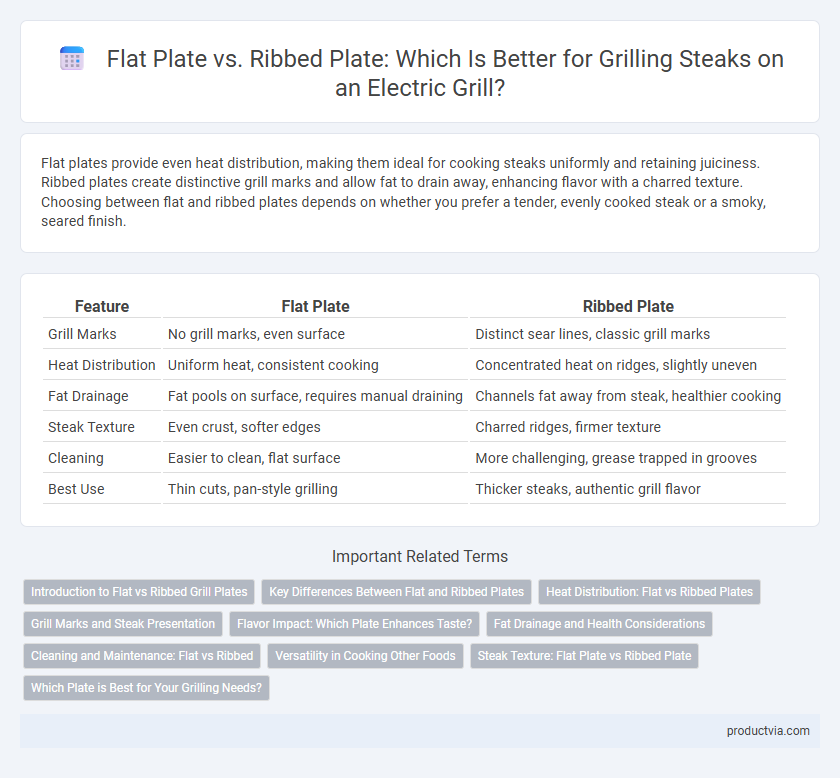Flat plates provide even heat distribution, making them ideal for cooking steaks uniformly and retaining juiciness. Ribbed plates create distinctive grill marks and allow fat to drain away, enhancing flavor with a charred texture. Choosing between flat and ribbed plates depends on whether you prefer a tender, evenly cooked steak or a smoky, seared finish.
Table of Comparison
| Feature | Flat Plate | Ribbed Plate |
|---|---|---|
| Grill Marks | No grill marks, even surface | Distinct sear lines, classic grill marks |
| Heat Distribution | Uniform heat, consistent cooking | Concentrated heat on ridges, slightly uneven |
| Fat Drainage | Fat pools on surface, requires manual draining | Channels fat away from steak, healthier cooking |
| Steak Texture | Even crust, softer edges | Charred ridges, firmer texture |
| Cleaning | Easier to clean, flat surface | More challenging, grease trapped in grooves |
| Best Use | Thin cuts, pan-style grilling | Thicker steaks, authentic grill flavor |
Introduction to Flat vs Ribbed Grill Plates
Flat grill plates provide even heat distribution ideal for cooking steaks uniformly, resulting in a tender and juicy texture. Ribbed grill plates create sear marks and allow fat to drain away, enhancing flavor and producing a classic grilled appearance. Choosing between flat and ribbed plates affects cooking style, steak texture, and cleanup ease.
Key Differences Between Flat and Ribbed Plates
Flat plates offer even heat distribution and a smooth surface that enhances direct contact with the steak, resulting in consistent cooking and a tender crust. Ribbed plates create distinctive grill marks and allow excess fat to drain away, which contributes to a slightly charred texture and reduced grease. Choosing between flat and ribbed plates depends on whether you prefer uniform cooking and easy cleanup or the visual appeal and flavor variation from grill lines.
Heat Distribution: Flat vs Ribbed Plates
Flat plates provide uniform heat distribution, ensuring consistent cooking across the entire steak surface and promoting even caramelization. Ribbed plates create elevated ridges that concentrate heat in distinct lines, producing grill marks but potentially causing uneven cooking between ridges. Choosing between flat and ribbed plates depends on whether consistent heat or characteristic grill texture is the priority for steak preparation.
Grill Marks and Steak Presentation
Flat plates provide even heat distribution for consistent cooking but lack distinct grill marks, resulting in a more uniform steak appearance. Ribbed plates create pronounced grill marks that enhance steak presentation and offer slight fat drainage, giving steaks an appealing charred texture. Choosing between flat and ribbed plates depends on the desired visual appeal and texture of grilled steaks.
Flavor Impact: Which Plate Enhances Taste?
Flat plates provide an even cooking surface that retains juices, resulting in a consistently tender and flavorful steak. Ribbed plates create distinctive grill marks and allow fat to drip away, intensifying the charred, smoky flavor associated with traditional grilling. Choosing between flat and ribbed plates depends on whether you prioritize juiciness or the signature grill texture and taste.
Fat Drainage and Health Considerations
Flat plates provide even heat distribution, ensuring consistent cooking but lack channels for fat drainage, which can result in steaks cooking in their own grease and higher fat retention. Ribbed plates feature raised ridges that allow fat to drain away from the meat, reducing fat content and promoting healthier grilling by minimizing flare-ups and smoke. Choosing ribbed plates supports fat reduction and a healthier steak option without sacrificing grill marks or flavor.
Cleaning and Maintenance: Flat vs Ribbed
Flat plates offer a smooth surface that simplifies cleaning, making it easier to wipe away grease and food residues after grilling steaks. Ribbed plates have grooves that can trap fats and charred bits, requiring more detailed scrubbing and maintenance to prevent buildup and ensure hygiene. Choosing a flat plate can reduce cleaning time and effort, while ribbed plates may demand frequent attention to maintain optimal performance.
Versatility in Cooking Other Foods
Flat plates offer greater versatility for cooking a wide range of foods beyond steaks, such as vegetables, pancakes, and eggs, due to their smooth surface that allows even heat distribution and prevents smaller items from falling through. Ribbed plates mimic traditional grill marks and are ideal for searing meats, but their raised ridges can make cooking delicate or liquid-based foods more challenging. Choosing a flat plate enhances overall cooking flexibility, accommodating diverse recipes and meal preparation needs.
Steak Texture: Flat Plate vs Ribbed Plate
Flat plates provide uniform heat distribution, resulting in evenly cooked steaks with a tender, juicy texture and a consistent crust. Ribbed plates create distinct grill marks and allow fat to drain away, producing a firmer texture with a slightly charred, smoky flavor characteristic of outdoor grilling. Choosing between flat and ribbed plates depends on whether you prefer a smoother, evenly cooked steak or one with traditional grill lines and a chewier bite.
Which Plate is Best for Your Grilling Needs?
Flat plates provide even heat distribution, ensuring a uniformly cooked steak with a tender texture, ideal for those seeking consistent results. Ribbed plates create distinct grill marks and allow fat to drain away, enhancing flavor and imitating outdoor grilling for a more authentic steak experience. Choosing between flat and ribbed plates depends on whether you prioritize even cooking or the traditional grilled appearance and taste.
Flat plate vs ribbed plate for grilling steaks Infographic

 productvia.com
productvia.com